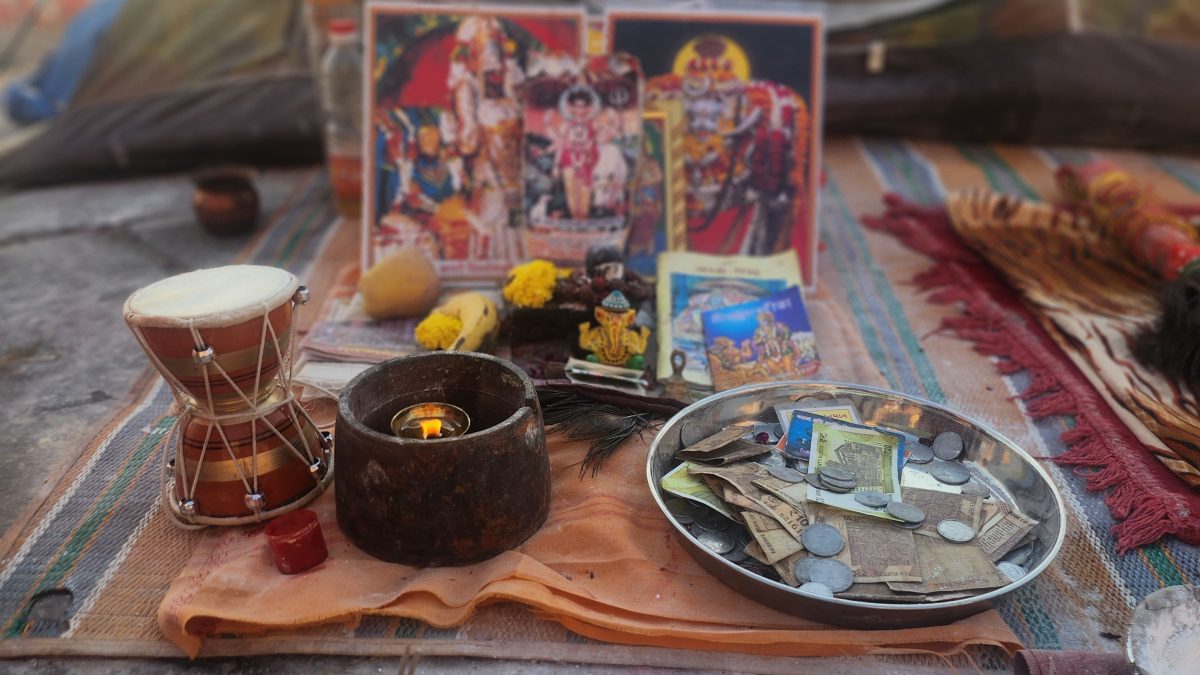Why are there so many Temples in India?
It is impossible not to notice all the temples & shrines (mandirs) in India. From magnificent structures (up to 160 acres in size!) to the tiniest of temples (a deity painted tile on the wall) mandirs are found literally everywhere. For example, in the city of Varanasi alone there are over 3,300 public Hindu mandirs – 175 classified as large in size, around 650 medium size, and over 2000 as “tiny” or “small”, and of the 500 odd remaining temples, 157 are tree mandirs.
The word mandir(a) comes from the Sanskrit verb ‘mad or mand’ meaning to tarry or stop so the word mandir literally means a place where a God has come to rest, where The Divine is present.
Whether I’ve been walking through the lush tropical hills of South India, relaxing on the beaches in East India, exploring the villages and busy cities of Central India, or climbing the mountains in North India, wherever there are Hindu people there and temples both big and small. This is because Hindu tradition holds that a town or village without a temple is simply unliveable. Historically only one God or Goddess was ever worshipped in a temple however now there are frequently numerous Gods, Goddesses and deities all found in the same place mandir, big or small.
A mandir is a place for large gatherings of faith, local community connection, family gatherings or solitary worship. Considered the home of God or a Deity, worship at a mandir offers intimate connection with a chosen representation of the Divine. They offer opportunities for community participation and belonging, sharing of family values and beliefs, and time for personal contemplation, reflection, and devotional practice.
At the heart of every mandir are sacred images or idols of the Divine and numerous objects of offering that form the centre of ceremony, ritual (puja), and worship. In larger community mandirs an appointed priest, or team of priests, normally perform the puja, whereas in small home Mandirs parents will usually perform the puja, and in tiny street mandirs individual devotees create their own offerings. One of the main functions of the temple is to create an atmosphere rich with Divine energy so when possible mandirs are built in places of spiritual significance.
While many mandirs are clearly pratiṣṭhita, or established by the community, many more are understood to be svayambhu, or self-arisen, and the deities enshrined inside are usually understood to have naturally occurred. The mandir then serves to honour the deity, and to make sure that those who come near to it know that a deity is present.
To watch a 10min explanation about a large community mandir go HERE

Worship in Community Temples
When they enter a mandir, a Hindu worshipper typically removes their shoes as a sign of respect and cleanliness in the house of the deities. The worshipper then enters the shrine room and rings a bell at the shrine of one of the gods or goddesses. This is a symbol of awakening the deity, and it also acts to focus the worshipper’s mind. They may then walk around the shrine while singing, chanting or praying. They may also present an offering, such as fruit, milk or money.
The purpose of worship in the mandir is to ‘have darshan’ of (or see) the gods and goddesses. Worship enables the devotee to clearly see – and be seen by – the divine. Prayers and hymns (such as bhajans) help the devotee to experience the divine presence. Hindu teaching says that worship comes from human hearts and minds and is expressed in actions.
The daily services of the mandir usually includes morning and evening aarati (flame) ceremonies led by a Brahmin priest. The priest’s role is to look after the murtis of the gods and goddesses in the temple by washing them and clothing them each day. The priest also feeds the gods by placing blessed food, called prashad at their feet. This food is then shared out with worshippers in the temple or given to people in need.
To watch an 8min explanation about a small community mandir go HERE
Tiny Wayside Temples
In India little wayside mandirs are dotted all over the place – on street corners, shop fronts, under trees, painted on walls, in caves, on rocks, on riverbanks, virtually in any spare space, help create a sacred energy and connection with the Divine for the community they serve. These small, humble, community created mandirs represent the devi/devata (God/Goddess), their boons and blessings, who protects the believers.
The little street mandir is a contemporary phenomenon of Indian life. They highlight the importance of worship for Hindus, and that a focal point of worship is the mandir a person considers to be their own. Little street mandirs whether they be posters, paintings, little statues, lingams, objects like tridents, horns, bowls, or jugs, and a collection of little offerings (water, flame, food, flowers) invite devotion into the everyday lives of people and act as reminders that everything is imbued with the essence of the Divine – including everyday actions and interactions.
Every little street mandir homes at least one Ishta devata (primary deity) and it is not uncommon to find more than one God or Goddess together in the same little street mandir, demonstrating the Hindu belief that the Divine manifests in a plethora of forms.
Little street mandirs are an integral part of daily life. Worshippers believe that by nurturing their mandirs with devotion that the daily struggles of daily life will improve, their families will be protected, and they will receive spiritual boons in return. Worship is offered offer first thing in the morning before work and at the end of the day. Offerings are replaced daily or as frequently as possible even by the poorest of people.
A holy tree or an unusual rock or a strange find are all it takes for someone to glorify the location and create a shrine on the spot. And soon enough the shrine develops a religious following, with the busy passers-by, stopping to pray for a minute and offer gratitude.
Tree shrines are a special case of street shrines. Mature Banyan and Pipal trees are commonly selected for women-only patronage. On certain festivals, women fast and tie red and yellow auspicious thread to the tree during the worship that involves 7 circumambulations.
A wayside mandir is a sacred place that a Hindu would never consider removing or destroying, even if it honours a deity that is different to their own. The area with a mandir requires respect and acts as a mini community overseer ensuring public behaviour is clean and dignified – no littering, spitting, urinating or fighting, or the Gods will be offended!
Wayside mandirs provide a place of worship for every Hindu regardless of caste or privilege, as visiting large temples can be costly (entry and offering fees) and prohibitive for some. Crowded larger temples also have strict worship rules and only allow a moment in the presence of the deity, making wayside mandirs more appealing for those wanting to spend time offering faith and devotion in their own way.
The Hindu notion of “seeing God everywhere” has a long history going back to the Bhagavad Gita. However, the ability to see God everywhere and in all things, has always been recognised as one of the most difficult attainments, one that takes constant attention to achieve. Wayside mandirs are a direct manifestation of Divine presence, they act as continual reminders that the Divine is not only present in formal houses of worship but also in everything and everywhere, they are direct manifestations of Divine presence and powerful symbols of Hindu faith.
To watch a 4min video all about the act of puja go HERE

Temples in the Home
In homes, mandirs are used as a meeting point for daily worship and religious events. They usually consist of a small pray house, deity idols, images, oil lamps, candles, incense, a water bowl and numerous offerings of fruit, flowers, rice, etc. A home mandir, often called a “pooja mandir,” holds immense significance as a dedicated space for personal prayer, meditation, and connecting with the divine. A mandir offers a place for personal devotion and family unity. It serves as a symbol of faith, as a personal sanctuary and a place to seek solace and blessings during both joyous and challenging times. It is a central element in Hindu households, where daily rituals are performed to maintain spiritual connection and cultural traditions. The practice of lighting incense, offering flowers, and chanting mantras in the home temple is a way to maintain spiritual discipline and mindfulness.
The ancient Indian science of architecture, Vastu Shastra, claims the best direction for the mandir to face is toward the northeast, as this position generates positive energies to invigorate prayers.
Home mandirs represent Divine energy, they are the home of God. The devotional practices carried out at a home puja act as offerings to the deity, gifts of gratitude to God in return for protection for oneself, family and business, for good health, for success, and for spiritual wealth.
To watch a 15min video on how to worship at a home puja go HERE
Having a dedicated home puja mandir acts as a daily reminder to spend time with the Divine, a practice that is proven to decrease stress, promote peaceful feelings and loving kindness, improve mental health and confidence and increase a greater sense of purpose. Worshipping daily or whenever needed offers a deep connection with Divine energy and creates a sense of safety in all that is done. A home mandir serves as the rite of passage from one generation to the other. It enables religious values and righteous morals to pass through generations, carrying family traditions.
To join me in travels to sacred Hindu lands go HERE



